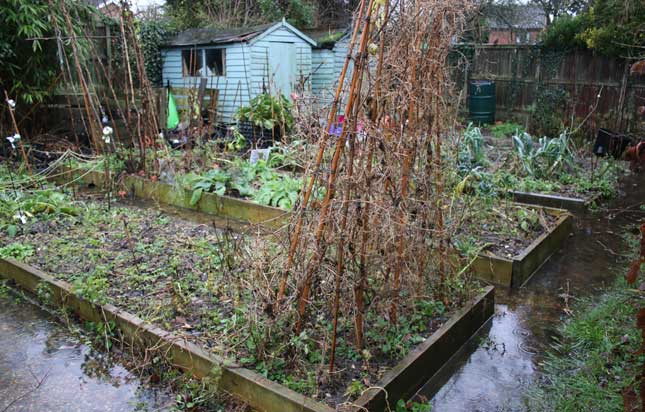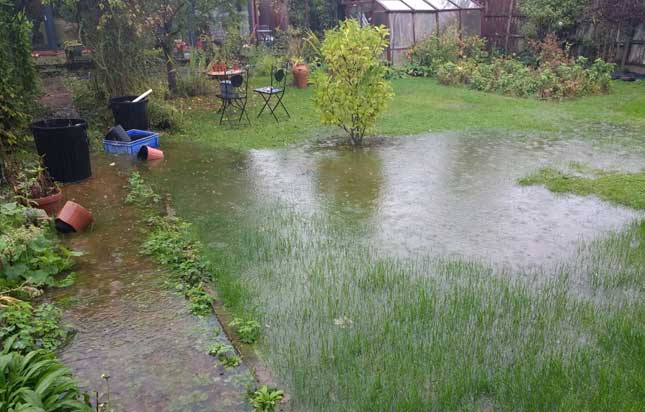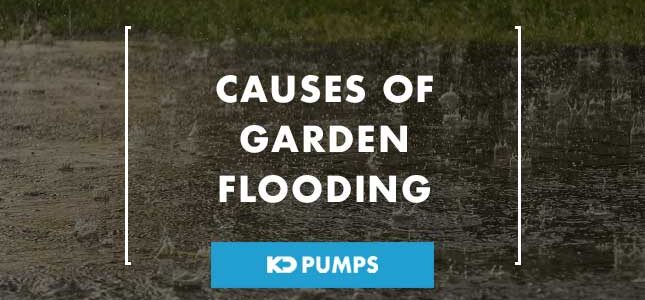Causes of Garden Flooding & How to Prevent It
A lush garden can be a sanctuary of tranquility, a haven of vibrant blooms.
However, the serenity and beauty can quickly disappear, replaced by a muddy mess and the distress of garden flooding.
Garden flooding can be a frustrating and costly problem, not to mention detrimental to the health of your plants.
Understanding the causes behind this phenomenon is the first step toward finding effective prevention measures to keep your garden thriving even in the face of nature’s watery onslaught.
In this blog, we will explore the various causes of garden flooding and delve into practical solutions to help you maintain a well-drained and harmonious garden environment.
Article Chapters
Symptoms of Garden Flooding

Image Credit: Shutterstock
The Royal Horticultural Society (RHS) mentions some common early signs of garden flooding are:
- The initial signs of the condition manifest on the leaves are characterised by yellowing or decay occurring between the veins. This leads to the formation of soft areas at the base or centre of the leaf.
- The plant exhibits symptoms resembling water shortage, such as wilting.
- Root sample analysis reveals blue-black roots, indicating flooding.
- Flooded roots may have a sour or rotting smell.
- Decay of roots can be severe, with only a few remaining intact.
- Damaged roots appear blackened, and the bark may peel away easily.
- Shoots may experience dieback due to inadequate moisture supply from the roots.
- Bark on shoots can easily peel off.
- Herbaceous plants may fail to sprout in spring or have leaves that open and subsequently wither.
- Stunted growth or plant mortality can be observed due to the condition known as oedema.
Has Your Garden Flooded?
The garden drainage issue you are experiencing may not be as significant or localised as initially thought.
Garden flooding typically occurs when water accumulates faster than it can drain from the area.
The severity of flooding depends on the disparity between the influx and outflow of water.
However, there are specific scenarios in which implementing a drainage solution may not be warranted.
Flooding After Heavy Rainfall
Following a period of heavy rain, instances of small-scale garden floods are common.
If your garden has experienced temporary flooding due to heavy downpours, it may not be a cause for significant concern.
However, if the ground remains excessively saturated for an extended period, resulting in a spongy or flooding condition lasting days or weeks, it may be necessary to seek a solution.
Fine During Isolated Showers, Bad During Prolonged Rainfall
The garden may drain adequately or quickly following isolated heavy rain showers in this scenario.
However, during sustained rainy periods, the problem intensifies.
This may indicate that the level of your garden is close to the water table; the level at which the soil and sediment become saturated with groundwater.
It’s important to note that the water table’s level is consistent across a significant land area and likely affects neighbouring properties.
In practical terms, there may be limited options for excess water to disperse, and in some cases, the groundwater may even rise to the surface within gardens.
If such occurrences are frequent, elevating the garden or a specific section may be the only viable solution to alleviate the issue and create a usable space.
Why Has My Garden Started Flooding?

Image Credit: Shutterstock
There are several reasons which can cause garden flooding. Some of them are:
Heavy Rainfall
One of the primary causes of garden flooding is excessive rainfall.
When rainfall exceeds the absorption capacity of the soil or overwhelms the drainage system, water accumulates in the garden.
This can result in waterlogged soil, saturation of plant roots, and surface flooding.
The intensity and duration of rainfall events play a significant role in determining the risk of garden flooding.
Poor Drainage
A poorly designed or inadequate drainage system can contribute to garden flooding.
Additionally, clogged or undersized gutters, downspouts, or underground drainage pipes can hinder the efficient water flow, leading to water buildup in the garden.
Topography & Landscape
The land’s natural topography can affect the drainage patterns in your garden.
If your garden is in a low-lying area or at the bottom of a slope, it may be more prone to flooding.
Areas with compacted or clay soil types tend to have poor drainage, making them susceptible to water accumulation.
Similarly, gardens near bodies of water or flood-prone regions are at higher risk of flooding.
Overwatering
While providing adequate water for your plants is essential, overwatering can contribute to garden flooding.
When plants receive more water than they can absorb or the soil can hold, excess water accumulates, saturating the soil and potentially causing flooding.
Improper irrigation practices, such as frequent watering or inefficient sprinkler systems, can exacerbate the problem.
Inadequate Soil Preparation
The composition and preparation of the soil in your garden can impact its drainage capabilities.
Compacted or heavy clay soils have poor drainage and may lead to water pooling.
Insufficient soil amendments, such as organic matter or compost, can limit the soil’s ability to absorb and retain water, increasing the risk of flooding.
Improper Garden Layout
The layout and design of your garden can inadvertently contribute to flooding.
For example, planting in low-lying areas or constructing raised beds without considering water flow can lead to water accumulation.
Additionally, if your garden features impervious surfaces like concrete or asphalt, rainwater cannot permeate the soil, increasing the chances of flooding.
How to Prevent Garden Flooding?
To prevent garden flooding, here are some measures you can take:
Reduce Artificial Surfaces
Promote better water absorption and minimise the presence of artificial surfaces in your garden to prevent garden flooding.
Instead, prioritise natural elements and absorbent materials.
Reducing the extent of artificial surfaces such as paving, concrete, or artificial grass allows better water infiltration into the soil, reducing runoff and potential flooding.
Opt for more green space, plantings, and absorbent materials to create an aesthetically pleasing and environmentally friendly garden.
Plant Leafy Vegetation
Planting leafy vegetation is a practical and natural solution to prevent garden flooding.
The dense foliage of leafy plants, including trees, shrubs, and ground cover plants, helps to intercept and slow down rainfall, allowing water to be absorbed more effectively into the soil.
The extensive root systems of these plants act as underground channels, enhancing water infiltration and reducing surface runoff.
The leaves also provide a protective layer, reducing the impact of heavy raindrops on the soil surface and minimising erosion.
With their ability to absorb and retain water, leafy vegetation plays a vital role in maintaining a healthy water balance, mitigating the risk of flooding and promoting overall garden resilience.
Install a Garden Drainage System
Installing a garden drainage system is a proactive approach to preventing flooding and effectively managing excess water.
A well-designed drainage system, such as French drains, channel drains, or catch basins, helps to redirect water away from the garden and prevent water accumulation.
These systems consist of underground pipes or channels that collect and channel water to a designated drainage area or a stormwater system.
By facilitating the efficient removal of water, a garden drainage system prevents soil saturation, and potential garden flooding.
You should also maintain your drainage system using professionals.
Maintain Healthy & Level Lawns
Maintaining healthy and level lawns is essential in preventing garden flooding.
A well-maintained lawn with healthy grass promotes proper water absorption, preventing surface water accumulation and reducing the risk of flooding.
Ensuring even water distribution across the lawn minimises water pooling in certain areas.
A level lawn allows water to penetrate the soil effectively, improving drainage and preventing garden flooding.
A healthy lawn with dense vegetation also acts as a natural barrier against soil erosion caused by heavy rainfall or runoff.
Regular lawn care practices, including mowing, aerating, and addressing any issues promptly, contribute to a healthy and level lawn that aids in flood prevention.
Use Gravel Support Mats with Gravel or Grass
Gravel support mats, combined with gravel or grass, effectively mitigate surface water flooding.
The Royal Horticultural Society (RHS) estimates that a significant proportion of front gardens in the UK are now paved, potentially exacerbating flooding issues as rainwater struggles to permeate the ground and overwhelms drainage systems.
Using plastic grids or gravel support, mats offer a more favourable solution, allowing rainwater to pass through while providing stability for parking or pathways.
These mats ensure water can penetrate the soil by incorporating grass or gravel. Additionally, some models use landscape fabric to prevent weed growth, enhancing their functionality.
Employ Rainwater Harvesting
Rainwater harvesting is an effective strategy to prevent garden flooding while simultaneously conserving water resources.
By capturing and storing rainwater, you can reduce the amount of runoff entering the garden and overwhelming drainage systems.
This helps to mitigate the risk of flooding during heavy rainfall events.
Rainwater can be collected from roofs, gutters, or other surfaces and directed into storage tanks or underground cisterns.
Install a Soakway
Soakaway installation refers to the process of constructing a soakaway system, also known as a soak pit or infiltration trench.
A soakaway is an underground structure designed to manage surface water runoff from roofs, driveways, or other impermeable surfaces.
It allows the water to slowly infiltrate into the ground, preventing waterlogging or garden flooding.
Frequently Asked Questions
How Do I Fix Drainage Problems in my Garden?
Drainage problems in a garden can lead to flooding soil, poor plant growth, and potential damage to plants and structures.
It’s best to get your flooded garden fixed by a professional.
Who’s Responsible for Garden Drainage?
The responsibility for garden drainage typically falls on the homeowner or property owner.
They’re generally responsible for maintaining and addressing drainage issues within their property, including managing and maintaining drainage systems.
What to Do If Your Patio Floods?
If your patio floods, first identify and address the source of the flooding, such as a clogged drain or improper grading.
Clear any debris, unclog drains, or redirect water flow.
If the problem persists, consult a professional for further assessment and potential solutions.
When Should I Seek Professional Help for Garden Flooding?
You may need to seek professional help for garden flooding if:
- The flooding is persistent or severe, causing significant damage to your property.
- You are unable to identify the source of the flooding or determine the appropriate measures to address it.
- You need assistance with the installation of drainage systems or the redesign of your garden for better water management.
- You require expert advice on managing water runoff or dealing with a high water table in your area.
Conclusion
Understanding the causes of garden flooding and implementing preventive measures is crucial for a flood-free garden.
Factors like heavy rainfall, poor drainage, and improper grading contribute to garden flooding.
Taking proactive steps such as proper land grading, installing effective drainage systems, and maintaining clear gutters can significantly reduce the risk.
Additionally, investing in reliable drainage services from professionals like KD Pumps can enhance flood prevention efforts.
Our expertise in installing efficient drainage systems can help redirect excess water away from your garden, effectively preventing flooding.
Feel free to get in touch with us today for help with fixing garden flooding.


Comments are closed.